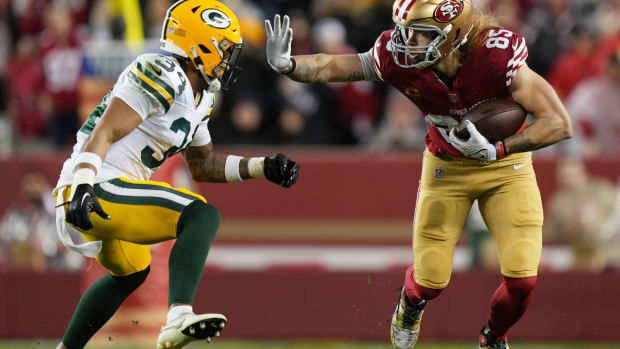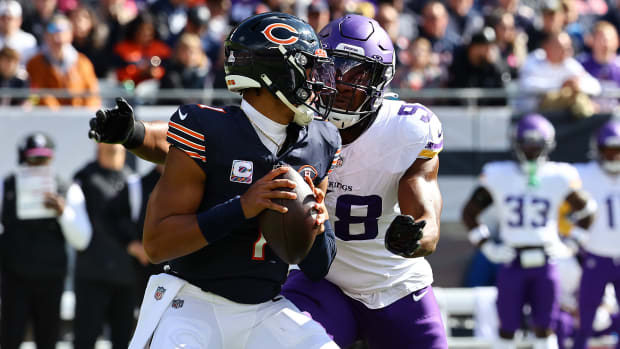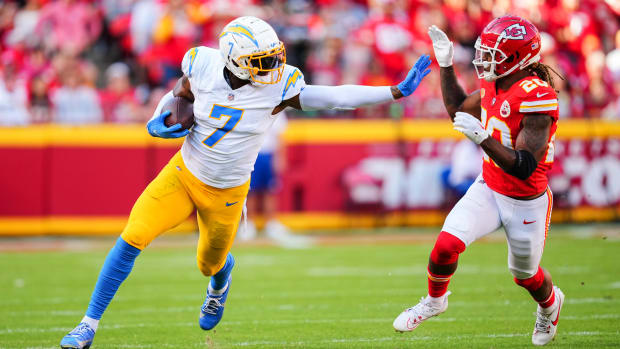Revisiting Bears' Decision to Sign Jimmy Graham
Jimmy Graham's signing sparked a firestorm of controversy, and now with the smoldering reduced to cold ash it's time to look at what caused the furor
The numbers show Graham makes the Bears so much better at the tight end position it makes the $16 million over two years seem like money well spent.
"When you talk to him, as well, you understand the knowledge that he has for the game," coach Matt Nagy said. "He's very, very motivated right now, which I love, and so it's just a fit for us of a big-sized, you know, 6-6 playmaker that you can get some mismatches with and I know me personally I'm very, very looking forward to being able to put him in some great situations."
They just drafted Cole Kmet, it's true, but really not for the same position.
"You really have two different styles to tight ens in this offense," GM Ryan Pace said. "You have the U tight end, that would apply more to Jimmy Graham, and you have the Y tight end, which is a little bit more of an in-line guy, good in the run game and he needs to gave the size to be able to do that and that's what we see in Cole."
Rookie tight ends almost always struggle, so whatever contribution they receive from Kmet this year will be a bonus.
It doesn't matter. They have someone capable, who has been better than a healthy Trey Burton was and not just earlier in his career but even in the last two years.
Here's how and why the Bears are better at tight end with Graham than they were last year with a cast of thousands playing the position.
Yards After Catch
In Graham, even at 33 years old, they still have one of the better tight ends at picking up yardage after the catch.
Last season at age 32 he gained 6.4 yards on average after receptions. This ranked fifth among all tight ends.
Only Noah Fant (8.3), Jonnu Smith (7.8) George Kittle (7.1) and Jordan Atkins (6.8) were better among tight ends according to statistics compiled by Sportradar, the official stat partner of the NFL.
Graham was better gaining yardage after the catch than Darren Waller (6.3), T.J. Hockenson (6.3), Dallas Goedert (5.7) and even Austin Hooper (4.5) and Travis Kelce (4.2).
Graham bounced back a bit last year in this regard after averaging just 4.7 yards and finishing 13th after the catch the previous season in Green Bay.
In both seasons he was better at yards after the catch than Trey Burton, even in 2018 when Burton was healthy.
When Graham came into the league he did much of his best after-catch work with his speed. He had a 40-yard dash time of 4.53 seconds at the NFL combine, fastest time among college tight ends coming into the league.
Now he's getting it done with technique and route running more than speed.
Dropped Passes
In Graham, they have one of the most sure-handed tight ends in the league. He dropped only 3.2% of the passes thrown his way in 2019 and 3.4% in 2018.
In 2019 he had the 12th lowest dropped pass percentage among tight ends and in 2018 he was seventh.
Graham's 3.2% drops was better than Waller (4.3), Godert (5.7) Zach Ertz (3.7), Hunter Henry (5.3) and Travis Kelce (5.9).
2018, Graham's 3.4% was better than Hooper (4.5), Kelce (4.7) Rob Gronkowski (4.2) and George Kittle (3.7).
Big Catches
In 2018, 58% of Graham's catches went for first downs and in 2019 60.6%. Both percentages put him toward the middle of the tight end pack. He made just five touchdown catches in two seasons with the Packers, but had 18 the previous three seasons in a different offense with Seattle.
Yardage
Graham's overall yardage per game dropped off significantly in Green Bay and in his final year with Seattle in 2017.
Age? Possibly.
He averaged 59.7 yards a game prior to those three seasons and 36.1 the last three, while his catch percentage/times targeted dropped from 65.3% his first seven years to 61.2% the last three.
The Ebron Factor
The signing situation which infuriated many Bears fans was how the Bears could pay $16 million guaranteed over two years for Graham when they could have signed Eric Ebron for about $12 million and two years.
It's a good thing fans don't make signings. Ebron is fine for fantasy football or if you play Madden. Graham is better in real life.
Ebron led all tight ends in dropped pass percentage last year (9.6) and was second in 2018 (8.3%). Last year the figure was triple Graham's dropped pass percentage and almost triple it in 2018.
While Graham was strong at yards after the catch, he only broke a tackle every 19 catches. He had two broken tackles last year. This doesn't sound like much, but it was 200% more than Ebron, who did not break a single tackle last year. Ebron didn't break a single tackle in 2018, either, according to Sportradar statistics.
Ebron catches passes slightly farther downfield than Graham, at 7.6 and 7.1 yards to 6.8 and 5.4 yards the last two years. This is more the offensive design for his position. Ebron was sometimes used as a wide receiver as much as a tight end so he ran deeper routes.
Because he doesn't break tackles and gains fewer yards after the catch than Graham, the net result is less yardage overall from Ebron.
And when Ebron's ability to drop passes at an astounding rate is figured in, it's a far less effective receiver.
It's better to pay $2 million more this year and next for better productivity.
As for the red zone work and overall touchdowns, Graham has had more than five touchdown catches six times in his career and 10 catches or more four times, while Ebron has had more than five TD catches once.
Ebron is the choice of fantasy football players who dwell in an alternate reality and remember a single season when Ebron produced big numbers but not when Graham had a season producing even bigger numbers.
Ebron is the choice of those who play too much Madden.
The Investment
While it was too much money for a tight end, the Bears had to have one. They'd already spent too much for one who played lame last year and didn't play their biggest game of the 2018 season. They needed someone who could produce when necessary, not a pass dropper who can't break tackles.
So they bit the bullet and took the best available for a two-year period to fill a gap because they had their eye on a young tight end who would need a season of seasoning.
Graham is no long-term investment and never was intended to be.
Summary
The Bears could have had Tyler Eifert, who played only 7.5 games a year the past four years and dropped 7.9% of passes sent his way last year.
They could have probably paid a draft pick ransom to pry loose O.J. Howard from the Bucs and had a player who was second last year only to Ebron among tight ends in dropped pass percentage (9.6). His best reception total was better only than Graham's worst total, in his rookie year.
They could have signed Austin Hooper for $26 million more than they paid Graham. And then they would have had to cut Leonard Floyd, but wouldn't have been able to sign Robert Quinn because they wouldn't have had the cap space. They probably would have had the space for any number of other signings, either.
So for the money what the Bears have is an aging tight end with plenty of ball skills and ability to gain yards after the catch, but obviously diminished over the last three seasons in general. He is someone who can still be especially effective in the red zone or at picking up first downs.
They have someone better than Eric Ebron, though not a longer-term investment that Ebron would have been if you really like spending money on pass-dropping players who can't break tackles.
Kmet's time will come soon enough, considering his skills.
They still hang onto Adam Shaheen, hoping something might click and then he could even be traded for a draft pick.
In the meantime, they know they are far better at the position because of Graham than they were with dozens of other tight ends who they've counted against their salary cap over the last two years.
Twitter: BearDigest@BearsOnMaven





